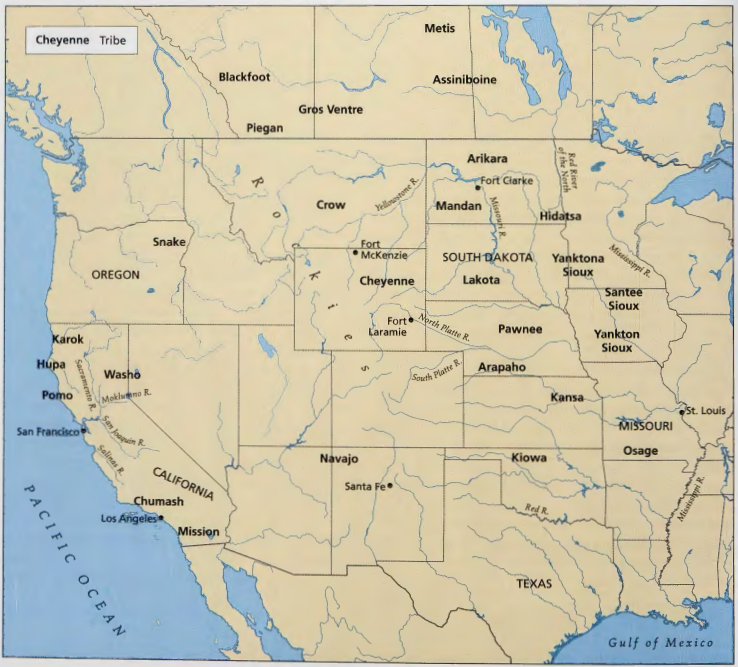7: Native and European Arts at the Boundaries of Culture- The Frontier West and Pacific Northwest, 1820s-1850s
- Page ID
- 169164
\( \newcommand{\vecs}[1]{\overset { \scriptstyle \rightharpoonup} {\mathbf{#1}} } \)
\( \newcommand{\vecd}[1]{\overset{-\!-\!\rightharpoonup}{\vphantom{a}\smash {#1}}} \)
\( \newcommand{\id}{\mathrm{id}}\) \( \newcommand{\Span}{\mathrm{span}}\)
( \newcommand{\kernel}{\mathrm{null}\,}\) \( \newcommand{\range}{\mathrm{range}\,}\)
\( \newcommand{\RealPart}{\mathrm{Re}}\) \( \newcommand{\ImaginaryPart}{\mathrm{Im}}\)
\( \newcommand{\Argument}{\mathrm{Arg}}\) \( \newcommand{\norm}[1]{\| #1 \|}\)
\( \newcommand{\inner}[2]{\langle #1, #2 \rangle}\)
\( \newcommand{\Span}{\mathrm{span}}\)
\( \newcommand{\id}{\mathrm{id}}\)
\( \newcommand{\Span}{\mathrm{span}}\)
\( \newcommand{\kernel}{\mathrm{null}\,}\)
\( \newcommand{\range}{\mathrm{range}\,}\)
\( \newcommand{\RealPart}{\mathrm{Re}}\)
\( \newcommand{\ImaginaryPart}{\mathrm{Im}}\)
\( \newcommand{\Argument}{\mathrm{Arg}}\)
\( \newcommand{\norm}[1]{\| #1 \|}\)
\( \newcommand{\inner}[2]{\langle #1, #2 \rangle}\)
\( \newcommand{\Span}{\mathrm{span}}\) \( \newcommand{\AA}{\unicode[.8,0]{x212B}}\)
\( \newcommand{\vectorA}[1]{\vec{#1}} % arrow\)
\( \newcommand{\vectorAt}[1]{\vec{\text{#1}}} % arrow\)
\( \newcommand{\vectorB}[1]{\overset { \scriptstyle \rightharpoonup} {\mathbf{#1}} } \)
\( \newcommand{\vectorC}[1]{\textbf{#1}} \)
\( \newcommand{\vectorD}[1]{\overrightarrow{#1}} \)
\( \newcommand{\vectorDt}[1]{\overrightarrow{\text{#1}}} \)
\( \newcommand{\vectE}[1]{\overset{-\!-\!\rightharpoonup}{\vphantom{a}\smash{\mathbf {#1}}}} \)
\( \newcommand{\vecs}[1]{\overset { \scriptstyle \rightharpoonup} {\mathbf{#1}} } \)
\( \newcommand{\vecd}[1]{\overset{-\!-\!\rightharpoonup}{\vphantom{a}\smash {#1}}} \)
THIS CHAPTER CONSIDERS the artistic products of the second great era of encounter between Native and white cultures-an encounter that occurred principally in the region known as the Great Plains, the vast plateau stretching from the Mississippi River west to the Rockies, and from Texas north into Canada (see map, fig. 7.1). Our time span in this chapter is more or less the same as in Chapters 6 and 8 (the decades before the Civil War), but our focus shifts to the trans-Mississippian West, where the dynamics of first encounter, long past in the East, were re-enacted. From the seventeenth to the nineteenth century, Native groups crisscrossed this region, and from the late eighteenth century on, contact with trappers, trading companies, and explorers vastly expanded their networks of exchange. At first, trappers and traders were searching for the beaver pelts that had fueled trade with Indians in previous centuries, supplies of which had been exhausted in the East. Later, plentiful deer, antelope, and buffalo hides attracted interest to the West. The explorers came in search of data about the landscape-geological features and natural resources that might serve colonization. Then, beginning in the 1840s, settlers from the East spread westward, fleeing exhausted farmlands in pursuit of the fabled new lands of the frontier.

What distinguished this post-1820 frontier encounter was an emerging expectation that the United States's political and social future lay in the West. This widely shared belief was driven by a sense of racial and national entitlement: the conviction that American democratic institutions-of northern European and Anglo-Saxon ancestry-were destined by providence to triumph over all other groups that claimed the land. "Manifest destiny" -the term coined in 1845 by the journalist John L. O'Sullivan was both a rallying cry for westward expansion, and the start of a new era of white/Indian relations that pitted the ambitions of the young nation-state against its territory's indigenous occupants. The economic and social opportunism released by Andrew Jackson's election to the presidency in 1828 found reinforcement in a sense of Protestant mission to redeem the wilderness from Indians, Catholics, and the mixed races of the Mexican frontier. With the annexation of Texas in 1845, the Oregon Territory in 1846 following a boundary dispute with Great Britain, and the Mexican Cession that concluded the Mexican-American War (1846-8), the vast territories of California, the Southwest, and the Pacific Northwest joined the Union in quick succession, expanding the United States into a nation that stretched from coast to coast. Southern slaveholding interests drove expansion as well, bringing a tense political antagonism to the process of national growth that would become a major precipitant of the Civil War.
The antebellum era encounter differed from earlier encounters not only in the assumption of racial supremacy that energized it, but also-paradoxically- in the impulse to document those very cultures whose way of life was threatened by this supremacy. These visual documents- "witnesses to a vanishing America" - were motivated by a desire to salvage a record of cultures believed to be on the edge of extinction.
Alternating between Native and white arts of the frontier, this chapter explores what the encounter with new environments and new people meant for each. We also include indigenous arts and arts of encounter from Alaska. Falling outside the continental boundaries of the United States, and becoming U.S. territory only in 1867, Alaska did not occupy a place in the nation's collective dream of continental empire; nevertheless, like other "remote" frontier areas, it was a crossroads of cultures in these same years.
Thumbnail: ALFRED JACOB MlLLER, Interior of Fort Laramie (detail), 1858-60. Watercolor and white body paint on paper, 11⅝ x 14⅛ in (29.7 x 35.8 cm). Walters Art Museum, Baltimore, Maryland.


